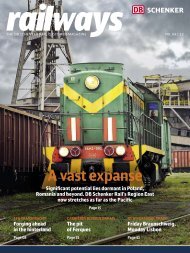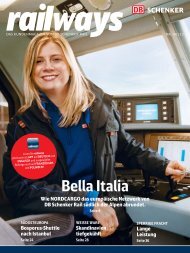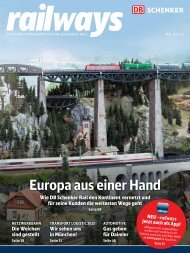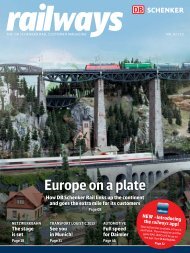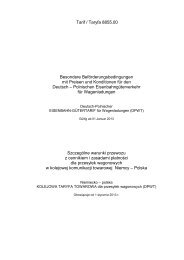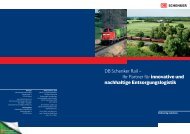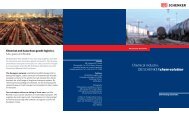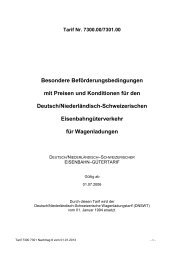PDF Download
PDF Download
PDF Download
Create successful ePaper yourself
Turn your PDF publications into a flip-book with our unique Google optimized e-Paper software.
LINGEN<br />
Germany<br />
SOPRON<br />
Austria<br />
Hungary<br />
Serbia<br />
ORESTIADA<br />
Macedonia<br />
Greece<br />
3,000 Kilometres Southeastwards<br />
The aac transports travel from Lingen in Emsland to Greece via Austria,<br />
Hungary, Serbia and Macedonia. The wagons reach the Austria-Hungary<br />
border in single wagon load traffic and from there they travel to their<br />
destination in the northeast of Greece in block trains.<br />
Photo: Bundesverband Porenbeton; Chart: Illuteam 43<br />
Autoclaved aerated concrete is a special construction material<br />
because, despite its high strength, it consists<br />
mainly of air. It is not just its low weight that has made<br />
autoclaved aerated concrete increasingly popular in recent years.<br />
Its favourable thermal insulation properties and excellent ecobalance<br />
in production make it a construction material with a real<br />
future.<br />
Autoclaved aerated concrete is produced from a mixture of<br />
quartz sand, limestone, water and some aluminium powder which<br />
foams and swells up in a mould due to a chemical reaction.<br />
The blocks are cut into their final shape while still soft and are<br />
then steam hardened in an autoclave where heat and pressure are<br />
applied. Anton Felber, Managing Director of aac-concept GmbH,<br />
says, “Although autoclaved aerated concrete has been around<br />
since the 1920s, we are constantly developing improvements to<br />
the production technology. We are talking here not just about the<br />
properties of the construction material itself but also about cost<br />
efficiency and environmental compatibility during its production.”<br />
aac-concept is a consultant with a global reputation in the construction<br />
and modernisation of autoclaved aerated concrete<br />
plants. In addition to providing consultancy, planning and project<br />
management, the engineers from Schrobenhausen in Upper Bavaria<br />
also put their customers in touch with plant manufacturers<br />
and take care of the purchasing and supply of part and complete<br />
plants.<br />
Ecology Becoming Increasingly Important<br />
According to Felber, “Ecology is playing an increasingly important<br />
part in the operation of autoclaved aerated concrete plants<br />
– so it was obvious to switch our transports to the environmentally<br />
compatible railway. What’s more, DB Schenker Rail could<br />
guarantee us better transport times for our transports to Greece<br />
than we could get by using trucks.”<br />
DB Schenker Rail recently transported an autoclave from Lingen<br />
in Emsland to aac’s customer Porobeton in Orestiada in the<br />
far northeast of Greece - a distance of over 3,000 kilometres. The<br />
autoclave which will make the production of autoclaved aerated<br />
concrete more efficient consists of a large number of individual<br />
parts including plates and tubes. Annette Wilms-Langer from<br />
Regional Sales South at DB Schenker Rail explains, “It was a challenge<br />
to dismantle and load the plant so that the space available<br />
in the wagons could be used to the best advantage.”<br />
Earlier deliveries for aac meant transporting moulds and hardening<br />
bases, and there was also a complete crushing plant which<br />
is used to crush the waste materials occurring during production<br />
so that they can be returned to the production process. Ms Wilms-<br />
Langer says, “This means that we are dealing with very different<br />
types of cargo which provide our loading consultants with fresh<br />
challenges each time.”<br />
The aac wagons initially reach Sopron on the Austro-Hungarian<br />
border as single wagon load traffic. There they are formed<br />
into block trains for their journey through the Balkans into<br />
Greece. Wilms-Langer says, “Our Power Railer product offers<br />
fixed connections in Southeast Europe several times a week, making<br />
it possible for the aac deliveries to arrive in northeast Greece<br />
in just one week.”<br />
Contact | Annette Wilms-Langer<br />
Phone: +49 (0)911 219-5562 | annette.wilms-langer@dbschenker.eu<br />
RAILWAYS | 17




